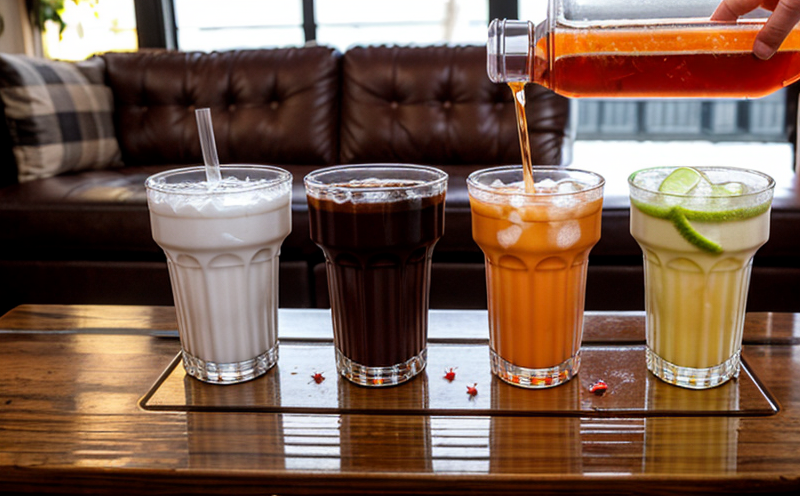ASTM D6781 Shelf Life Stability Testing in Beverages
The shelf life of beverages is a critical factor that influences consumer satisfaction and product compliance. ASTM D6781 provides a standardized method for determining the shelf life stability of packaged beverages under various storage conditions, ensuring consistent quality over time.
Shelf life testing involves exposing samples to specific temperature and humidity conditions for extended periods, simulating real-world storage scenarios. This process helps manufacturers identify when a product’s quality begins to degrade, thereby allowing them to set appropriate shelf life guidelines. The ASTM D6781 protocol is particularly useful in the food & feed sector as it ensures that beverages meet regulatory standards and consumer expectations.
For R&D engineers working on new beverage formulations, this test can provide invaluable insights into how different ingredients interact under various temperature conditions. Quality managers also benefit greatly from this service, as they can use the results to make informed decisions about labeling and storage instructions. Compliance officers will appreciate the standardized approach ASTM D6781 offers for ensuring that products meet international standards.
The testing procedure involves packaging samples of the beverage in standard containers and placing them into a controlled environment. The temperature is then varied over time, typically starting from room temperature down to refrigeration or freezing levels. Samples are monitored at regular intervals using various analytical techniques such as sensory analysis, chemical composition assays, and microbiological evaluation.
| Condition | Description | Range | Frequency of Monitoring |
|---|---|---|---|
| Temperature | Simulating storage conditions | Room temperature to -20°C (-4°F) | Every 7 days or as needed |
| Humidity | Relative humidity influencing shelf life | 30% RH to 95% RH | Every 14 days or as needed |
The ASTM D6781 protocol also emphasizes the importance of selecting appropriate samples for testing. These should represent the entire batch, including any potential variations in formulation or packaging. Once tested, results are analyzed to determine at what point significant changes occur in the beverage’s quality parameters.
- Potential quality issues that can be detected include color change, flavor alteration, increased acidity, and microbial growth.
- These tests help ensure product consistency across different batches and regions.
- The findings from ASTM D6781 are crucial for maintaining brand reputation and meeting consumer demand for freshness and safety.
Applied Standards
The primary standard used in this testing is ASTM D6781, which specifies the procedure for determining shelf life stability of packaged beverages. This standard is widely recognized and adopted by beverage manufacturers worldwide due to its reliability and accuracy.
In addition to ASTM D6781, other relevant standards include ISO 22000 for food safety management systems and HACCP (Hazard Analysis and Critical Control Points) principles that focus on preventing contamination. By adhering to these international guidelines, laboratories ensure they provide accurate and consistent testing results.
The use of ASTM D6781 not only ensures compliance with regulatory requirements but also supports the development of safer and more reliable beverages. It helps manufacturers set realistic shelf life expectations based on scientific evidence rather than guesswork or arbitrary timeframes.
Environmental and Sustainability Contributions
ASTM D6781 plays a vital role in promoting sustainability within the beverage industry by encouraging manufacturers to set realistic shelf life expectations. By accurately predicting when products begin to degrade, companies can reduce waste associated with expired goods.
This approach also contributes positively to resource conservation efforts, as it minimizes unnecessary production and distribution of subpar or expired beverages. Moreover, adherence to this standard enhances consumer trust in the brand by delivering consistently high-quality products.
For laboratories conducting these tests, proper implementation ensures that their facilities are environmentally friendly and efficient. They can contribute further by adopting eco-friendly practices such as recycling test materials and reducing energy consumption during testing processes.
Use Cases and Application Examples
- New Product Development: ASTM D6781 helps R&D teams understand how their new beverage formulations perform under different storage conditions. This information is crucial for optimizing product design and enhancing marketability.
- Quality Assurance: Quality managers use these test results to verify that each batch of beverage meets the required quality standards before being released into the marketplace.
- Compliance Verification: Compliance officers ensure their products comply with local and international regulations by referencing ASTM D6781 findings during audits and inspections.
| Beverage Type | Initial Quality Parameters | Final Quality Parameters After Testing | Shelf Life Estimation (Months) |
|---|---|---|---|
| Soda | Color: Clear, Flavor: Sweet, pH: 3.5 | Color: Slightly Browned, Flavor: Mildly Sweetened, pH: 4.0 | 6 months |
| Juice | Color: Golden Yellow, Flavor: Citrusy, pH: 3.8 | Color: Darkened, Flavor: Less Citrusy, pH: 4.2 | 9 months |





